Zoom
Trash

Fairy. Paralumun New Age Village. Norse mythology: a guide to the Gods, heroes, rituals, and beliefs - John Lindow. Troll - Citizendia. Three Billy Goats Gruff. Folktales of Aarne-Thompson type 122E translated and/or edited by D.
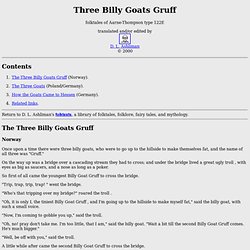
L. Ashliman © 2000 Contents Return to D. Albanian Mythology - The Apricity Forum: Cultural & Ethnic European Preservation. Zmeu. The Zmeu (plural: zmei, feminine: zmeoaică/zmeoaice) is a fantastic creature of Romanian folklore and Romanian mythology.

Sometimes compared to other fantastic creatures, such as the balaur or the vârcolac, the zmeu is nevertheless distinct, because it usually has clear anthropomorphic traits: it is humanoid and has legs, arms, the ability to create and use artifacts such as weapons, or the desire to marry young girls. In some stories, Zmeu appears in the sky and spits fire. In other stories, it has a magical precious stone on its head that shines like the sun. It likes beautiful young girls, whom it kidnaps, usually for the purpose of marrying them.
It is almost always defeated by a daring prince or knight-errant. Name[edit] TROLLS. Allen Varney: Earthdawn Legends (Troll) Few readers know troll legends.
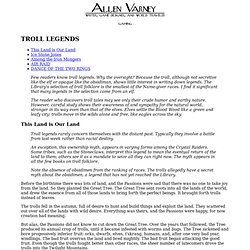
Giant Mythical Creatures. 347 creatures (and 116 alternative names) Hide alternative names Giants come from all myths and cultures ranging from being larger than average people to colossal beings the size of the planet.
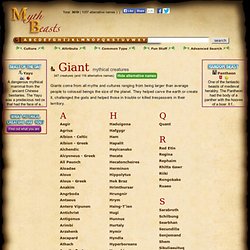
Tork, mythical creature. Nothing special (9 votes).
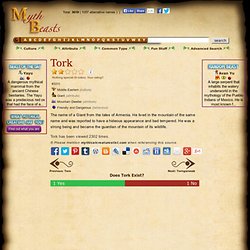
Your rating? #3311 Middle Eastern (culture) Giant (attribute) Mountain Dweller (attribute) Friendly and Dangerous (behaviour) The name of a Giant from the tales of Armenia. Three Billy Goats Gruff. "Three Billy Goats Gruff" (Norwegian: De tre bukkene Bruse) is a Norwegian fairy tale.[1] The fairy tale was collected by Peter Christen Asbjørnsen and Jørgen Moe in their Norske Folkeeventyr, first published between 1841 and 1844.[2] It has an "eat-me-when-I'm-fatter" plot (Aarne-Thompson type 122E).
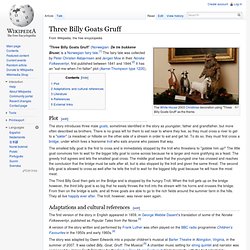
Plot[edit] The story introduces three male goats, sometimes identified in the story as youngster, father and grandfather, but more often described as brothers. There is no grass left for them to eat near to where they live, so they must cross a river to get to a "sæter" (a meadow) or hillside on the other side of a stream in order to eat and get fat. Inca Mythology - Myth Encyclopedia - god, story, legend, ancient, animal, war, world, creation, life, king. The Inca civilization flourished in the Andes mountains of South America during the A .
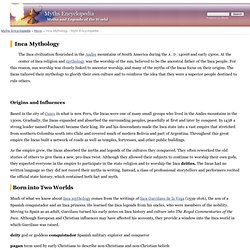
D . 1400S and early 1500s. At the center of Inca religion and mythology was the worship of the sun, believed to be the ancestral father of the Inca people. Bogeyman. Goya's Que viene el Coco ("Here Comes the Bogeyman / The Bogeyman is Coming") c. 1797 A bogeyman (also spelled bogieman, boogeyman, or boogie man, and pronounced /bʊɡimæn/ or /boʊɡimæn/)[1] is a mythical creature in many cultures used by adults or older children to frighten bad children into good behavior.
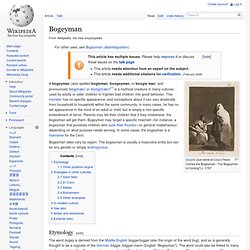
This monster has no specific appearance, and conceptions about it can vary drastically from household to household within the same community; in many cases, he has no set appearance in the mind of an adult or child, but is simply a non-specific embodiment of terror. Parents may tell their children that if they misbehave, the bogeyman will get them. Bogeymen may target a specific mischief—for instance, a bogeyman that punishes children who suck their thumbs—or general misbehaviour, depending on what purpose needs serving. Buggane. In Manx mythology, a Buggane was a huge ogre-like creature, native to the Isle of Man.
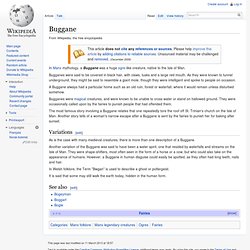
Bugganes were said to be covered in black hair, with claws, tusks and a large red mouth. As they were known to tunnel underground, they might be said to resemble a giant mole, though they were intelligent and spoke to people on occasion. A Buggane always had a particular home such as an old ruin, forest or waterfall, where it would remain unless disturbed somehow. The most famous story involving a Buggane relates that one repeatedly tore the roof off St. Trinian's church on the Isle of Man.
Variations[edit] Ogre. Puss in Boots before the ogre.
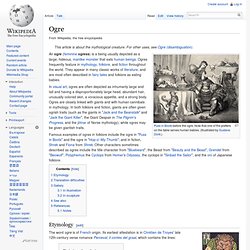
Note that one of the platters on the table serves human babies. (Illustrated by Gustave Doré.) General folklore . Mythology, folklore, and religion. Native American mythology. Jötunn. The jötnar (anglicized jotunn or jotun, plural jötnar; /ˈjoʊtən/, /ˈjoʊtʊn/, or /ˈjɔːtʊn/; Icelandic: [ˈjœːtʏn]; from Old Norse jǫtunn /ˈjɔtunː/; often glossed as giant or ettin) can be seen throughout Norse mythology. The Jötnar are a mythological race that live in Jötunheimr, one of the nine worlds of Norse cosmology. They were banished there by the Æsir who refuse them entry to their world, Asgard. The Jötnar frequently interact with the Æsir, as well as the Vanir. They are usually in opposition to, or in competition with, them but also interact with them in a non-hostile manner. Some Jötnar even intermarry with the Æsir and Vanir. Etymology[edit] Topics. BUMBA : Mighty Creator God of Vomit from African Mythology.
From the Bushongo in the Congo comes BUMBA, the African Creator God of Vomit. Trow - Shetlopedia - The Shetland Encyclopaedia. Henkies - Shetlopedia - The Shetland Encyclopaedia. Troll, mythical creature. There are many variations of the Troll from Norse mythology. The name is Norse for monster. Danish trolls have large noses, are extremely ugly and wear a craftsman's apron with a red cap and a white long beard. In Ebletoft Trolls had humps on their backs and hooked noses wearing grey jackets and a red cap. In Gudmanstap Trolls differed by being tall in size and wearing black clothes. In Norway there are said to also be ugly but are also hairy. Generally Trolls lived in communities under hills in long barrows and ancient earthworks.
Some Trolls were very rich an possessed much treasure. In the Middle Ages they are fiends that wield black magic. Adamastor. Statue of Adamastor by Júlio Vaz Júnior, inaugurated in 1927 at the Santa Catarina viewpoint, Lisbon, Portugal. Adamastor is a Greek-type mythological character famed by the Portuguese poet Luís de Camões in his epic poem Os Lusíadas (first printed in 1572), as a symbol of the forces of nature Portuguese navigators had to overcome during their discoveries.
Camões gave his creation a history as one of the Gigantes of Greek mythology who had been spurned by Thetis, now appearing in the form of a threatening storm cloud to Vasco da Gama and threatening ruin to anyone hardy enough to pass the Cape and penetrate the Indian Ocean, which was Adamastor's domain. Adamastor became the Spirit of the Cape, a hideous phantom of unearthly pallor: "Even as I spoke, an immense shape Materialised in the night air,
Gallu. In Sumerian and Akkadian (Babylonian and Assyrian) mythology, Gallu (also called galla) or Telal is a great underworld demon. Role Gallu demons hauled unfortunate victims off to the underworld. Katherine Langrish - Troll Blood - Native American Folklore. The Native American Indians you will meet in ‘Troll Blood’ are based on the Mi’kmaq people of New Brunswick, Canada, who have a rich heritage of amazing stories and traditions. I spent many months researching these, and listed my sources in the American edition. Pukwudgies: Myth or Monster. Pukwudgie. Definition for troll. A Dictionary of Northern Mythology: Amazon.co.uk: Rudolf Simek, Angela Hall: 9780859915137.